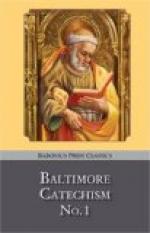91 Q. After Christ had remained forty days on earth, whither did He go? A. After forty days Christ ascended into Heaven, and the day on which He ascended into Heaven is called Ascension Day.
One day He was on a mountain with His Apostles and disciples; and as He was talking to them He began to rise up slowly and quietly, just as you have sometimes seen a balloon soar up into the air without noise. Higher and higher He ascended; and as they gazed up at Him, the clouds opened to receive Him, then closed under Him: and that was the last of Our Lord’s mission as man upon earth. The Ascension took place forty days after the resurrection. (Acts 1).
92 Q. Where is Christ in Heaven? A. In Heaven Christ sits at the right hand of God the Father Almighty.
93 Q. What do you mean by saying that Christ sits at the right hand of God? A. When I say that Christ sits at the right hand of God, I mean that Christ as God is equal to His Father in all things, and that as man He is in the highest place in Heaven next to God.
Lesson 9 ON THE HOLY GHOST AND HIS DESCENT UPON THE APOSTLES
94 Q. Who is the Holy Ghost? A. The Holy Ghost is the Third Person of the Blessed Trinity.
95 Q. From whom does the Holy Ghost proceed? A. The Holy Ghost proceeds from the Father and the Son.
96 Q. Is the Holy Ghost equal to the Father and the Son? A. The Holy Ghost is equal to the Father and the Son, being the same Lord and God as they are.
97 Q. On what day did the Holy Ghost come down upon the Apostles? A. The Holy Ghost came down upon the Apostles ten days after the Ascension of Our Lord; and the day on which He came down upon the Apostles is called Whit-Sunday or Pentecost.
We have seen already that the Apostles fled and were very much afraid when Our Lord was taken prisoner. Even Peter, the chief of the Apostles, who said he would die rather than leave Our Lord, shamefully denied Him; and St. John, the beloved disciple, stood near the Cross, but offered no resistance to Our Lord’s enemies. After the Crucifixion of Our Lord, the Apostles, afraid of being put to death, shut themselves up in a room. Ten days after Our Lord’s Ascension they were praying as usual in their room, when suddenly they heard the sound as it were of a great wind, and then they saw tongues the shape of our own, but all on fire, coming, and one tongue resting on the head of each Apostle present. (Acts 2).
This was the Holy Ghost coming to them. The Holy Ghost, being a pure spirit without a body, can take any form He pleases. He sometimes came in the form of a dove; so when you see a dove painted in a church near the altar, it is there to represent the Holy Ghost. You could not paint a spirit, so angels and God Himself are generally represented in pictures as they at some time appeared to men.
“Whit-Sunday,” or White-Sunday; probably so called because in the early ages of the Church converts were baptized on the day before, and after their Baptism wore white robes or garments as a mark of the soul’s purity after Baptism.




